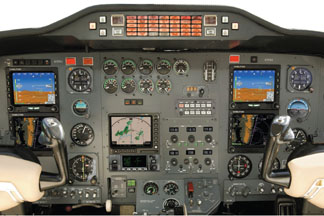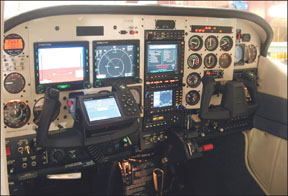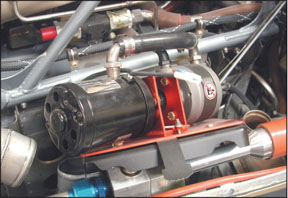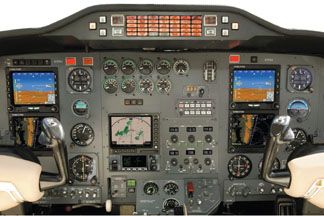by Paul Bertorelli
Had it up to here with all the glossy color ads extolling the virtues of cutting-edge EFIS installed in airplanes you cant re motely afford? We know the feeling and we know plenty of owners who share it and who pine for the wonders of bleeding-edge glass-panel flying. Why, for example, cant you just retrofit one of the blasted things into, say, a nice 20-year-old Saratoga?

324
You can. Its simply a question of money and, for a few owners, its a not-necessarily-out-of-the-question sum if the upgrade is expressed as a percentage of the airplanes overall value. we’ll concede that this is the sort of gauzy rationalization you can easily talk yourself into after a couple of bourbons, but then the same could be said of owning an airplane in the first place.
Glass is available for the old togas panel and for the moment, there’s only one source: Chelton Flight Systems. Although Avidyne says it will offer a reduced-feature EFIS for the aftermarket, Chelton, by necessity, has already been doing that for four years, with more than 300 systems flying in various classes of aircraft from piston singles to turboprops. Unlike Garmin and Avidyne, Chelton doesnt have any high-volume OEMs yet, although FlightLogic has been selected as original equipment for the Bell 417 helicopter.
As an immediate point of depart- ure, think money first and think of something north of $100,000 for a Chelton FlightLogic system. It wouldnt be impossible for the invoice to be closer to $150,000. Owners who have had the Chelton installed in older airplanes say you can plan for at least two to three months of downtime and a period of debugging after that, although increasingly, thanks to support from Chelton, experienced shops should be able to get a FlightLogic system right from the start.
And the payoff on this investment? In our view, Cheltons FlightLogic display, with its unique synthetic vision and Highway in the Sky, is hands down the most sophisticated and imaginative application of this technology that weve seen. The system is relatively easy to learn and retain, offers unusual flexibility in installation and is well-supported by Chelton. Further, it can be installed readily if not cheaply in almost any airplane flying.
On the downside, without the volume of OEM sales, Cheltons developmental pace is not as brisk as Garmins or Avidynes. For instance, datalink weather display for the FlightLogic has been slow in coming and engine monitoring isn’t on the drawing board yet. There are workarounds for this, but some buyers writing six-figure checks understandably want it all right now. Those awaiting lower prices may have to wait, too. Chelton is considering a lower-priced offering, but has nothing to announce yet.
HistoryEven before Garmin or Avidyne got much traction with their EFIS designs, Sierra Flight Systems stunned the Experimental world at Oshkosh with its sophisticated flight system that, uniquely, depicted terrain in three-dimensional detail behind a primary flight display with a distinctly military look. At each show, Sierra added features and the system generated intense interest (and buyers) among homebuilders.
Chelton, a division of the UK-based aerospace conglomerate, Cobham, was looking for a fast entry into the civil EFIS market and evidently found it in Sierra, which it purchased in 2001. Chelton accelerated the push toward a certified version of the Sierra, which it achieved in 2003, just as Cirrus announced that it would sell airplanes equipped only with glass, Avidynes Entegra.
With Garmin and Avidyne fighting it out in the OEM market, Cessna, Raytheon/Beechcraft, Diamond, Columbia and New Piper all offer glass as standard or optional equipment, which left no place for Chelton to go except the aftermarket.
Since 2003, it has pursued a dual marketing strategy, with the certified version selling under the Chelton FlightLogic nameplate while the Experimental EFIS version was sold under the original Sierra name. Lately, the Sierra moniker has been less in evidence if not dropped entirely. Cheltons EFIS for homebuilts is marketed exclusively by a third party, Direct To Avionics.
ArchitectureIn our March 2006 issue, we published a detailed analysis comparing Garmins G1000 and Avidynes Entegra. Although the two share similarities, they are at opposite poles with regard to clarity of display and ease of operation. In our view, Cheltons FlightLogic resides between the two with respect to ease of use. Its display complexity exceeds the G1000-which is to say there’s lots of data to soak in during a typical flight-but we found it easier to learn and retain than the G1000.
In basic architecture, all three systems are similar, consisting of discrete modules-displays, GPS units, an AHRS solid state gyro/magnetometer system, comm boxes and an air data computer all linked into a working whole. While Avidyne has integrated its components into the same chassis that mount the displays and it must rely on external Garmin GPS navigators, Cheltons architecture is closer to the Garmin approach. It has its own GPS but no comm radios.
However, unlike Garmin, Chelton relies on vendors for some of its major boxes, including Crossbow for the AHRS gyro package, FreeFlight for the 12-channel WAAS GPS and Shadin for the air data computer. Iterations of the FlightLogic system requiring higher certification use components from other sources, such as Collins or LITEF.
The FlightLogic can navigate itself without an external GPS-including GPS approaches-but it relies on someone elses external hardware for communication and for ILS or localizer approaches. Curiously, the FlightLogic is flexible enough to accommodate virtually any existing navcomm, including ancient Bendix/King KX-170Bs, a combination youre unlikely to see. However, the aircraft we flew for this report had a KX-165 and an older KNS-80 RNAV set-up, which appeared to work well.

One conspicuous difference between the FlightLogic and its Garmin and Avidyne counterparts is screen size. The FlightLogics two displays are substantially smaller at 6.25 inches wide by 5.5 inches high compared to 10 inches wide for the Garmin and Avidyne.
This cuts both ways, in our view. Because of its compact size, the FlightLogic will fit in practically any airplane and its smaller screens give the option of vertical rather than horizontal pairing, a significant advantage, in our view.
But both of the FlightLogics screens are packed with data and symbols and at times, we found the screens challenging to read. By comparison, the Garmin and Avidyne displays are luxuriously spacious and don’t tend to jam up the field of view with as much information. They also do less than the FlightLogic, in terms of projecting navigation and terrain awareness.
Screen size aside, its whats on those screens that matters and among Cheltons unique claims are two features: synthetic vision and the Highway in the Sky course display option. These ideas arent new by Chelton, but its the first company to integrate them in a certified civil EFIS.
Youve seen enough PFDs to know that the brown lower portion represents the dirt and the blue upper the sky. On the G1000 and Entegra, these representations are inert and static, while on the FlightLogic theyre animated by a computerized representation of both traffic and terrain.
The FlightLogic is equipped with a detailed and TAWs-capable terrain database which it uses to sketch a three-dimensional rendition of the terrain below against a vanishing-point gridwork. The database has elevation information to 30-arc second detail and it essentially connects the dots to build a visual model of the terrain. The view lacks the sharp-edged detail of a real mountain but the soft, rounded rendering is close enough. It also depicts towers and other man-made hazards.
We thought one of the coolest things SV does is to depict traffic on the PFD puttering along above the horizon at the right azimuth, complete with a datablock showing relative altitude and trend info. On an approach, it also depicts a virtual runway against the grid backdrop with sufficient detail and perspective to mimic the view out the windshield. Its all quite impressive.
The so-called Highway in the Sky display-which Chelton calls skyway-is best thought of as a three-dimensional visual representation of the desired course. It consists of a series of endlessly generated boxes or windows which appear on the distant horizon and loom ever closer as the airplane flies toward the selected fix.
The simple idea-and it works-is to point the airplanes nose through the boxes and simply follow them to the waypoint or destination. don’t worry about heading or intercepting a course manually. Although it can be frustrating to attempt to fly through the center of each box, that turns out not to be necessary since in scale each box is 320 by 400 feet with the boxes spaced 2000 feet apart. That means even clipping the edge of a box keeps you less than 200 feet from the course centerline.
Installing ItWhen EFIS technology became practical for light aircraft, Cirrus, Cessna and others found that installing it correctly wasnt a trivial exercise. Its quite another thing to shoehorn this complex, multi-component equipment into an older airplane that has accreted decades of ancient wiring and patched together boxes. To get a sense of whats required and what it costs, we spoke with three shops doing FlightLogic installs and we visited with O&N Aircraft Modifications in Factoryville, Pennsylvania, a leading installer of FlightLogic systems.
If youre contemplating a FlightLogic install, know this up front: Its probably the largest, most expensive and most involved modification available, with the exception of a turbine conversion, although Chelton gets shop kudos for delivering a complete, high-quality package. In most cases, installing the FlightLogic will require stripping the old panel back to the cool side of the firewall and reassembling from scratch. To get everything to play reliably, the airplane will need to be rewired.
During our O&N shop tour, Bill Miller showed us a Cessna P210 whose interior had been gutted in preparation for a FlightLogic install. A couple of weeks alone is dedicated to building up and testing the custom wiring harness. Without rewiring, Miller says, “you can only make the job as good as the guy ahead of you.” Given the finicky nature of EFIS, thats not likely to be good enough.
Miller told us the FlightLogics basic installed price is about $100,000. “But don’t be surprised if the estimate goes higher than that,” he added. The basic FlightLogic includes the essentials for EFIS flight and terrain mapping, but it doesnt include external sensors for traffic, weather or lightning. Nor does it include the custom metal panel most owners want to go along with the expensive hardware. The final invoice will depend on what boxes are already in the panel. For our imaginary owner with older radios, say KX-170s, a navcomm upgrade will be a must. The cheap solution might be a Garmin GNS430 and an SL30 navcomm or even a couple of SL30s to provide comms and LOC/GS capability, neither of which the FlightLogic has. These will add another $10,000 to $15,000 to the invoice.
Since the FlightLogic cant yet display any weather except Stormscope returns, you could use the GNS430s screen for that or add a Garmin GMX 200 or Avidyne EX500, budget and panel room permitting. O&N installs the FlightLogic in its high-dollar P210 Rolls-Royce turbine conversions and uses the SL30/MX-20/200 combination as standard.
Then there’s the question of back-up instrumentation, which gives would-be FlightLogic owners unusual flexibility. In its turbines, O&N uses vacuum-driven gyros for standby duty while a test Mooney we flew has all-electric standby, including a Bendix/King HSI the aircraft left the factory with.
That aircraft, Lloyd Zands Continental-converted Mooney PFM, has two batteries and two alternators, giving it as much redundancy as any single could conceivably need. (Further, like the G1000, the FlightLogic has screen reversion capability.) Miller told us his regional FSDO has been cooperative in allowing practical solutions for FlightLogic approvals. But we caution that this might not be the case everywhere.
What Owners SayWe interviewed three owners who have installed FlightLogic systems and when asked to assess the system, we heard words such as “awesome” and “fabulous.” But owners were less enthusiastic about their installation experiences, with one describing it as a months-long nightmare.
O&N enjoys a well-regarded reputation because its among the most Chelton-experienced shops in the U.S. Owner Richard Leofsky, who bought O&Ns FlightLogic for his P210 turbine conversion, told us the project took a month longer than anticipated, but credits O&N with cautioning him up front about potential delays. Further, he says O&N and Chelton provided exceptional support for minor problems after the sale.
Lloyd Zand said he got similar top-drawer support from Chelton for his Mooney PFM conversion, but his experience with the installing shop-a Ft. Lauderdale avionics outlet-was far less satisfactory. “It was a nightmare,” he said, with the airplane down from April to August 2004 and plagued by serious malfunctions caused by errors in installation, despite the shop having been recommended as being FlightLogic experienced.

“My mistake,” Zand told us, “was not talking to owners who had the first few installations.” Zand eventually insisted that Chelton make the system right, which it did by referring him to Modern Avionics, a Minneapolis shop which corrected the earlier shops installation blunders. When we flew his aircraft, the FlightLogic had no apparent bugs and Zand was thrilled with it.
Field Morey told us hes just as impressed with the FlightLogic but reserves judgment for Cheltons after-the-installation support. Morey is we’ll known for his IFR adventure trips through the western states and Alaska and, hoping to give his clients some glass-panel face time, he installed the FlightLogic in his 1985 Cessna 182 TurboRG. Morey reports that his clients like the FlightLogic and find it learnable, although it takes several hours to become comfortable with the system. (Richard Leofsky estimated 50 hours for his comfort level.)
But like Zand, Morey suffered installation delays and ongoing problems after the installation. What was supposed to take one month, took three and hes had to replace two PFDs and one MFD, which Chelton has covered under warranty.
“Ive been frustrated with the number of failures,” says Morey, who has some 350 hours behind the FlightLogic system. “Weve had a malfunction on nearly every trip. Ive been really disappointed in the number of things that have gone wrong.” Morey believes much of this is simply due to Cheltons lack of long-term experience with its system and shortcuts by the installing shop.
When we asked Morey to characterize his view of Cheltons customer service, he replied that it was fair, but not exceptional. He said on several occasions Chelton representatives promised timely callbacks but failed to deliver. At press time, Cheltons marketing vice president, Randy Shimon, said the company was aware of Moreys complaints and was attempting to contact him.
We asked all three owners if, having spent $100,000 plus for the FlightLogic system, they would do it again. All replied without qualification that they would, including Field Morey, who believes his maintenance issues will eventually sort themselves out. None of the three owners we interviewed entertained any illusions about the economic sense of spending $100,000 to upgrade an older piston single and expecting to recover much of the investment. On the other hand, Field Morey reasoned that his upgraded Cessna 182 Turbo RG is as capable as a new Cirrus or Columbia, yet still represents less than half the investment.
“I think Ive got a great airplane. Im hopeful that the problems Ive had are just bugs to be sorted out, just as with any other piece of equipment,” Morey said.
ConclusionWe are impressed enough with the FlightLogic system to speculate that if any OEM offered new airplane customers the choice of all three systems-Garmin, Avidyne and Chelton-a significant number would pick the Chelton. We think its display logic and design is the best of the three by a significant margin. One owner pointed out that while the G1000 and Entegra designs merely animate traditional steam gauges in nice colors, the FlightLogic stitches together all the flight information at its disposal and displays it in imaginative, innovative and easy-to-understand ways. We agree with that sentiment. We found the screens to be on the small side, but this shouldnt be a deal breaker.
But price might be. Is all this capability really worth $100,000 or more? We say the answer is a conditional yes. In the rarified world of this spending level, the only owners shopping are those who have sufficient disposable income not to have to worry about recovering the investment at resale or those who can justify it with a business plan. If either describes you and youre planning to keep your airplane for the foreseeable future, by all means consider the FlightLogic. Chelton is realistic enough to realize that for the aftermarket, many of its systems will go into turboprop or high-end piston twins. Until and unless it introduces a medium-price option-and we see that coming-single-engine aftermarket EFIS will be limited.
All of the EFIS systems are too new for us to make informed judgments about long-term reliability and cost of ownership. we’ll examine that in a future article. Our research suggests that Cheltons support of the FlightLogic system is generally excellent although, as Field Morey notes, timely callbacks from customer service could stand improvement. Were encouraged that Cheltons Randy Shimon takes this seriously and pledges improved follow-up.
Contact – Chelton Flight Logic, 208-389-9959, www.flightlogic.com/.


